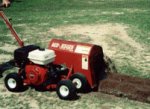junkhound
Senior Member
- Location
- Renton, WA
- Occupation
- EE, power electronics specialty
Stand alone 500W microhydro installation.
crossflow turbine and custom generator (300V/500 Hz nominal rewound delco alternator) at stream, 900 feet away
1. assume NEC does not apply, consider system as an experiment. No untrained persons involved.
2. what is best feeder configuration, given what is available (have a lot of UF) is 12-2 wg UF - consider both safety, economy, and line loss.
a. send the 3 phase ungrounded delta (using the ground as a phase conductor) as wild frequency to the cabin, rectify there with buck/boost to feed 400V dc link of 120Vac inverter (and 14V dc)
or,
b. rectify at the generator and send variable dc to the cabin to feed similar electronics, either with ground (as ground) or bare UF conductor in parallel with one of the conductors.
or,
c. other suggestions?
crossflow turbine and custom generator (300V/500 Hz nominal rewound delco alternator) at stream, 900 feet away
1. assume NEC does not apply, consider system as an experiment. No untrained persons involved.
2. what is best feeder configuration, given what is available (have a lot of UF) is 12-2 wg UF - consider both safety, economy, and line loss.
a. send the 3 phase ungrounded delta (using the ground as a phase conductor) as wild frequency to the cabin, rectify there with buck/boost to feed 400V dc link of 120Vac inverter (and 14V dc)
or,
b. rectify at the generator and send variable dc to the cabin to feed similar electronics, either with ground (as ground) or bare UF conductor in parallel with one of the conductors.
or,
c. other suggestions?


